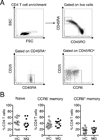Autoreactive T Cells from Patients with Myasthenia Gravis Are Characterized by Elevated IL-17, IFN-γ, and GM-CSF and Diminished IL-10 Production
- PMID: 26826242
- PMCID: PMC4761502
- DOI: 10.4049/jimmunol.1501339
Autoreactive T Cells from Patients with Myasthenia Gravis Are Characterized by Elevated IL-17, IFN-γ, and GM-CSF and Diminished IL-10 Production
Abstract
Myasthenia gravis (MG) is a prototypical autoimmune disease that is among the few for which the target Ag and the pathogenic autoantibodies are clearly defined. The pathology of the disease is affected by autoantibodies directed toward the acetylcholine receptor (AChR). Mature, Ag-experienced B cells rely on the action of Th cells to produce these pathogenic Abs. The phenotype of the MG Ag-reactive T cell compartment is not well defined; thus, we sought to determine whether such cells exhibit both a proinflammatory and a pathogenic phenotype. A novel T cell library assay that affords multiparameter interrogation of rare Ag-reactive CD4(+) T cells was applied. Proliferation and cytokine production in response to both AChR and control Ags were measured from 3120 T cell libraries derived from 11 MG patients and paired healthy control subjects. The frequency of CCR6(+) memory T cells from MG patients proliferating in response to AChR-derived peptides was significantly higher than that of healthy control subjects. Production of both IFN-γ and IL-17, in response to AChR, was also restricted to the CCR6(+) memory T cell compartment in the MG cohort, indicating a proinflammatory phenotype. These T cells also included an elevated expression of GM-CSF and absence of IL-10 expression, indicating a proinflammatory and pathogenic phenotype. This component of the autoimmune response in MG is of particular importance when considering the durability of MG treatment strategies that eliminate B cells, because the autoreactive T cells could renew autoimmunity in the reconstituted B cell compartment with ensuing clinical manifestations.
Copyright © 2016 by The American Association of Immunologists, Inc.
Figures






Similar articles
-
Interferon-gamma, interleukin-4 and transforming growth factor-beta mRNA expression in multiple sclerosis and myasthenia gravis.Acta Neurol Scand Suppl. 1994;158:1-58. Acta Neurol Scand Suppl. 1994. PMID: 7732782
-
The effect of interleukin (IL)-21 and CD4+ CD25++ T cells on cytokine production of CD4+ responder T cells in patients with myasthenia gravis.Clin Exp Immunol. 2017 Nov;190(2):201-207. doi: 10.1111/cei.13006. Epub 2017 Jul 28. Clin Exp Immunol. 2017. PMID: 28671717 Free PMC article.
-
Autoreactive T and B cells in nervous system diseases.Acta Neurol Scand Suppl. 1993;142:1-56. Acta Neurol Scand Suppl. 1993. PMID: 8382894
-
CD4+ T cells and cytokines in the pathogenesis of acquired myasthenia gravis.Ann N Y Acad Sci. 2008;1132:193-209. doi: 10.1196/annals.1405.042. Ann N Y Acad Sci. 2008. PMID: 18567869 Review.
-
On the initial trigger of myasthenia gravis and suppression of the disease by antibodies against the MHC peptide region involved in the presentation of a pathogenic T-cell epitope.Crit Rev Immunol. 2001;21(1-3):1-27. Crit Rev Immunol. 2001. PMID: 11642597 Review.
Cited by
-
The safety and efficacy profile of eculizumab in myasthenic crisis: a prospective small case series.Ther Adv Neurol Disord. 2024 Jul 26;17:17562864241261602. doi: 10.1177/17562864241261602. eCollection 2024. Ther Adv Neurol Disord. 2024. PMID: 39072008 Free PMC article.
-
Advances in the role of helper T cells in autoimmune diseases.Chin Med J (Engl). 2020 Apr 20;133(8):968-974. doi: 10.1097/CM9.0000000000000748. Chin Med J (Engl). 2020. PMID: 32187054 Free PMC article. Review.
-
Rifaximin Prevents T-Lymphocytes and Macrophages Infiltration in Cerebellum and Restores Motor Incoordination in Rats with Mild Liver Damage.Biomedicines. 2021 Aug 12;9(8):1002. doi: 10.3390/biomedicines9081002. Biomedicines. 2021. PMID: 34440206 Free PMC article.
-
Roles of GM-CSF in the Pathogenesis of Autoimmune Diseases: An Update.Front Immunol. 2019 Jun 4;10:1265. doi: 10.3389/fimmu.2019.01265. eCollection 2019. Front Immunol. 2019. PMID: 31275302 Free PMC article. Review.
-
Advances in autoimmune myasthenia gravis management.Expert Rev Neurother. 2018 Jul;18(7):573-588. doi: 10.1080/14737175.2018.1491310. Epub 2018 Jul 4. Expert Rev Neurother. 2018. PMID: 29932785 Free PMC article. Review.
References
-
- Vincent A, Beeson D, Lang B. Molecular targets for autoimmune and genetic disorders of neuromuscular transmission. Eur J Biochem. 2000;267:6717–6728. - PubMed
-
- Sanders DB. Clinical neurophysiology of disorders of the neuromuscular junction. J Clin Neurophysiol. 1993;10:167–180. - PubMed
-
- Querol L, Illa I. Myasthenia gravis and the neuromuscular junction. Curr Opin Neurol. 2013;26:459–465. - PubMed
-
- Beeson D, Brydson M, Betty M, Jeremiah S, Povey S, Vincent A, Newsom-Davis J. Primary structure of the human muscle acetylcholine receptor. cDNA cloning of the gamma and epsilon subunits. Eur J Biochem. 1993;215:229–238. - PubMed
Publication types
MeSH terms
Substances
Grants and funding
LinkOut - more resources
Full Text Sources
Other Literature Sources
Medical
Research Materials

